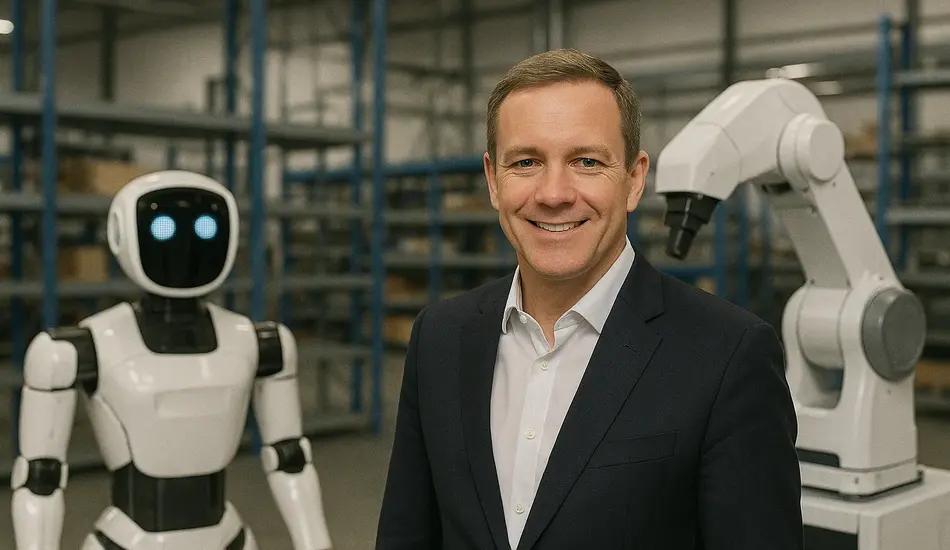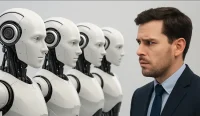2025 has been dubbed “the year of the humanoid robot,” and while they aren’t on every street corner yet, they are here and revolutionizing industries at an unprecedented pace. Meet Coid, the G-1 Ultimate robot, a next-generation humanoid platform that represents the future of robotics and the massive investment opportunities that come with it.
The G-1 Ultimate: A Glimpse into the Future
The G-1 Ultimate robot represents the cutting edge of humanoid technology, with capabilities that were science fiction just years ago. Priced at over $60,000 for the special education and research development version, these robots are currently in the education phase, showing people what’s possible and preparing the market for more affordable consumer versions in the future.
The G-1 platform has become the most popular globally because it’s an open-source platform, allowing developers worldwide to contribute to its evolution. Every day, new capabilities are being added, and every month, developers are finding new industries that robots can revolutionize – industries they had no idea existed.
The Market Explosion: From Inquiries to Investment
The Robostore receives hundreds of inquiries every day from people around the world, demonstrating the massive global interest in humanoid robots. The most common request? “Can you just clean my house?” This reflects the universal desire for robots to handle mundane tasks, just like Rosie from The Jetsons that many of us grew up watching.
The market is responding with unprecedented enthusiasm. The first global humanoid ETF was launched in June, providing investors with access to the entire ecosystem that goes into the future of robotics. This ETF represents the whole ecosystem, from the robots themselves to the components and technologies that power them.
The $5 Trillion Opportunity: Ground Floor Investment
This represents the ground floor of global humanoid robots, giving investors a great entry point right now. The industry is predicted to be a $5 trillion market with 1 billion robots around the world – a massive pie to slice up. This isn’t just about the robots themselves; it’s about the entire ecosystem that supports them.
Companies like NVIDIA, Tesla, and MP Materials are becoming household names as they fuel the long-term trend for robotics. NVIDIA, which three years ago maybe 10% of Americans had heard of, is now known by everyone. These are the companies that are going to fuel the long-term trend for robotics going forward.
The Hardware-Software Gap: Unlimited Potential
The amazing part about humanoid robots is that the hardware capabilities are way above the current software capabilities. This means there’s unlimited potential for growth as software catches up to the hardware’s capabilities. New features and capabilities are being developed every day, with developers constantly pushing the boundaries of what these robots can do.
The G-1 platform can perform incredible feats like backflips, demonstrating the advanced hardware that’s already available. As software development accelerates, we’ll see these robots become capable of increasingly complex tasks, from household chores to industrial applications.
Hardware Leads — But Software Will Define the Future
Humanoid robotics has reached a turning point. The G-1 platform’s backflips show what’s possible in hardware — now software must catch up. Engineers, developers, and innovators who bridge that gap will shape the next decade of automation. The demand for robotics software, AI control systems, and embedded engineering is only accelerating.
Post a Job Free for 30 Days →Industry Revolution: Every Month Brings New Possibilities
Every month, we’re finding a new industry that robots can revolutionize, and we had no idea these opportunities existed. This constant discovery of new applications is what makes the humanoid robot market so exciting and unpredictable. From healthcare to manufacturing, from entertainment to education, robots are finding their way into every sector of the economy.
The speed of innovation is exponential. Every day, the technology gets better, and every month, new industries are being revolutionized. This rapid pace of change is creating opportunities that investors and entrepreneurs couldn’t have imagined just a few years ago.
The Investment Landscape: Diversified Opportunities
The humanoid robot market offers diversified investment opportunities across the entire value chain. From the robots themselves to the components that power them, from the software that controls them to the services that support them, there are multiple ways to invest in this revolution.
The Robostore currently features 15-16 different robot models, with the G-1 platform being the most popular globally due to its open-source nature. This diversity in the market means there are opportunities for different types of investors, from those looking for established companies to those seeking early-stage opportunities.
The Consumer Market: From $60,000 to Affordable
Currently, humanoid robots like the G-1 Ultimate cost over $60,000, making them accessible primarily to researchers, developers, and early adopters. However, the goal is to make these robots affordable for consumers to bring into their homes. The price ranges are all over the place right now, but the industry is working toward making these robots accessible to the average consumer.
This price reduction will be crucial for the mass adoption of humanoid robots. As costs come down and capabilities increase, we’ll see these robots move from research labs and specialized applications to everyday use in homes and businesses.
The Global Reach: Worldwide Interest and Adoption
The interest in humanoid robots is truly global, with inquiries coming from every corner of the world. This global demand is driving innovation and investment, as companies compete to meet the needs of different markets and cultures. The universal appeal of robots that can perform human-like tasks transcends borders and languages.
This global reach also means that the market opportunity is even larger than initially estimated, as different regions may have different needs and applications for humanoid robots.
The Global Race for Humanoid Talent Has Begun
From Tokyo to Toronto, companies are competing for roboticists, AI engineers, and hardware integration experts who can bring humanoid systems to life. Demand is outpacing supply — and those who hire early will lead the next industrial revolution. Whether you’re scaling production or building your first R&D team, the time to act is now.
Hire Robotics & AI Talent Worldwide →The 20-Year Trend: Long-Term Investment Opportunity
This isn’t a short-term fad; it’s a 20-year trend that’s just beginning. The humanoid robot revolution represents a fundamental shift in how we work, live, and interact with technology. Early investors have the opportunity to participate in what could be one of the most transformative technological shifts in human history.
The combination of advancing hardware, improving software, decreasing costs, and increasing demand creates a perfect storm for massive growth in the humanoid robot market.
The Bottom Line: The Future is Now
Humanoid robots are no longer science fiction; they’re here and revolutionizing industries every month. From the G-1 Ultimate robot demonstrating advanced capabilities to the global market responding with unprecedented enthusiasm, the humanoid robot revolution is accelerating at an exponential pace.
With a predicted $5 trillion market and 1 billion robots worldwide, this represents one of the greatest investment opportunities of our time. The ground floor is now, and those who position themselves early in this revolution stand to benefit from one of the most transformative technological shifts in human history.
The future isn’t coming; it’s here. And it’s wearing a robot suit.




